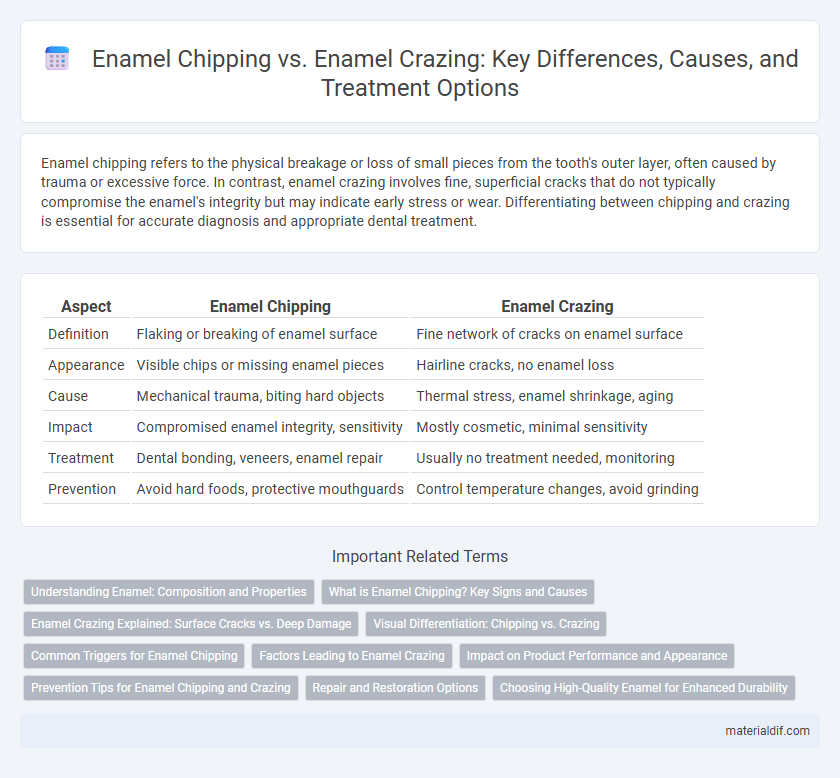Enamel chipping refers to the physical breakage or loss of small pieces from the tooth's outer layer, often caused by trauma or excessive force. In contrast, enamel crazing involves fine, superficial cracks that do not typically compromise the enamel's integrity but may indicate early stress or wear. Differentiating between chipping and crazing is essential for accurate diagnosis and appropriate dental treatment.
Table of Comparison
| Aspect | Enamel Chipping | Enamel Crazing |
|---|---|---|
| Definition | Flaking or breaking of enamel surface | Fine network of cracks on enamel surface |
| Appearance | Visible chips or missing enamel pieces | Hairline cracks, no enamel loss |
| Cause | Mechanical trauma, biting hard objects | Thermal stress, enamel shrinkage, aging |
| Impact | Compromised enamel integrity, sensitivity | Mostly cosmetic, minimal sensitivity |
| Treatment | Dental bonding, veneers, enamel repair | Usually no treatment needed, monitoring |
| Prevention | Avoid hard foods, protective mouthguards | Control temperature changes, avoid grinding |
Understanding Enamel: Composition and Properties
Enamel, the hardest tissue in the human body, consists mainly of hydroxyapatite crystals, providing exceptional hardness and brittleness. Enamel chipping occurs when localized mechanical forces cause fractures that dislodge enamel fragments, often due to impact or biting hard objects. In contrast, enamel crazing involves the formation of fine microcracks within the enamel surface, usually caused by long-term stress or thermal fluctuations, without actual loss of enamel material.
What is Enamel Chipping? Key Signs and Causes
Enamel chipping refers to the loss or breaking away of small pieces of tooth enamel, often caused by trauma, biting hard objects, or teeth grinding. Key signs include visible cracks or missing fragments on the enamel surface and sensitivity to temperature or pressure. This condition differs from enamel crazing, which consists of fine surface cracks without enamel loss.
Enamel Crazing Explained: Surface Cracks vs. Deep Damage
Enamel crazing refers to fine, surface-level cracks in the enamel that do not compromise the tooth's structural integrity, whereas enamel chipping involves the loss of small pieces of enamel, resulting in deeper, more visible damage. Crazing appears as a network of hairline fractures often caused by stress or thermal changes, and it primarily affects the enamel's outer layer without penetrating into dentin. Unlike chipping, enamel crazing generally does not require immediate dental intervention but should be monitored to prevent progression or aesthetic concerns.
Visual Differentiation: Chipping vs. Crazing
Enamel chipping appears as distinct, sharp-edged fragments missing from the surface, creating visible gaps, while enamel crazing manifests as a network of fine, hairline cracks without any material loss. Chipping disrupts the enamel integrity with clear breaks, often exposing underlying layers, whereas crazing looks like a spiderweb pattern subtly altering the enamel's smooth texture. Visual differentiation relies on identifying whether the enamel surface has discrete missing pieces (chipping) or only superficial crack lines (crazing).
Common Triggers for Enamel Chipping
Enamel chipping occurs when external forces such as biting hard substances, accidental trauma, or grinding teeth cause small pieces of the enamel to break off. Temperature extremes from consuming very hot or cold foods can also weaken enamel, increasing susceptibility to chipping. Poor oral hygiene and acid erosion from frequent consumption of sugary or acidic beverages further compromise enamel strength, making chipping more likely.
Factors Leading to Enamel Crazing
Enamel crazing occurs due to microfractures on the tooth surface caused by repeated stress from thermal changes, biting forces, and acidic erosion, weakening the enamel's structural integrity. Factors such as excessive grinding, frequent consumption of acidic foods and beverages, and rapid temperature fluctuations contribute significantly to enamel crazing. Unlike enamel chipping, which involves larger, visible chunks breaking off, enamel crazing appears as fine lines or cracks that may not immediately compromise tooth function but can lead to sensitivity if untreated.
Impact on Product Performance and Appearance
Enamel chipping results in visible loss of material, compromising both the aesthetic appeal and protective function of enamel-coated products by exposing underlying surfaces to corrosion and wear. Enamel crazing, characterized by fine surface cracks, primarily affects the visual smoothness and may lead to minor aesthetic degradation without immediate structural damage. While chipping severely diminishes product durability, crazing often signals stress that could evolve into more significant defects if untreated, impacting long-term performance.
Prevention Tips for Enamel Chipping and Crazing
Preventing enamel chipping and crazing requires maintaining strong dental hygiene by brushing with a soft-bristled toothbrush and fluoride toothpaste to protect enamel integrity. Avoid consuming acidic or highly sugary foods and beverages that weaken enamel, and use a mouthguard during sports to prevent mechanical damage. Regular dental check-ups enable early detection of enamel issues, enabling timely professional fluoride treatments or dental sealants to strengthen enamel and minimize chipping and crazing risks.
Repair and Restoration Options
Enamel chipping typically requires restorative treatments such as dental bonding or composite resin repair to rebuild lost enamel and protect the tooth structure. Enamel crazing, characterized by fine surface cracks, often benefits from polishing or the application of protective sealants to prevent further damage and enhance enamel durability. Both conditions may sometimes necessitate professional evaluation to determine the optimal repair strategy and maintain dental health.
Choosing High-Quality Enamel for Enhanced Durability
Enamel chipping involves the loss of small enamel fragments due to impacts or stress, whereas enamel crazing refers to fine surface cracks without material loss that can weaken structural integrity over time. Selecting high-quality enamel with enhanced chemical composition and controlled firing processes dramatically improves resistance to both chipping and crazing. Durable enamel coatings, often formulated with advanced borosilicate or feldspathic compounds, ensure long-lasting protection and maintain aesthetic appeal in demanding applications.
Enamel Chipping vs Enamel Crazing Infographic

 materialdif.com
materialdif.com